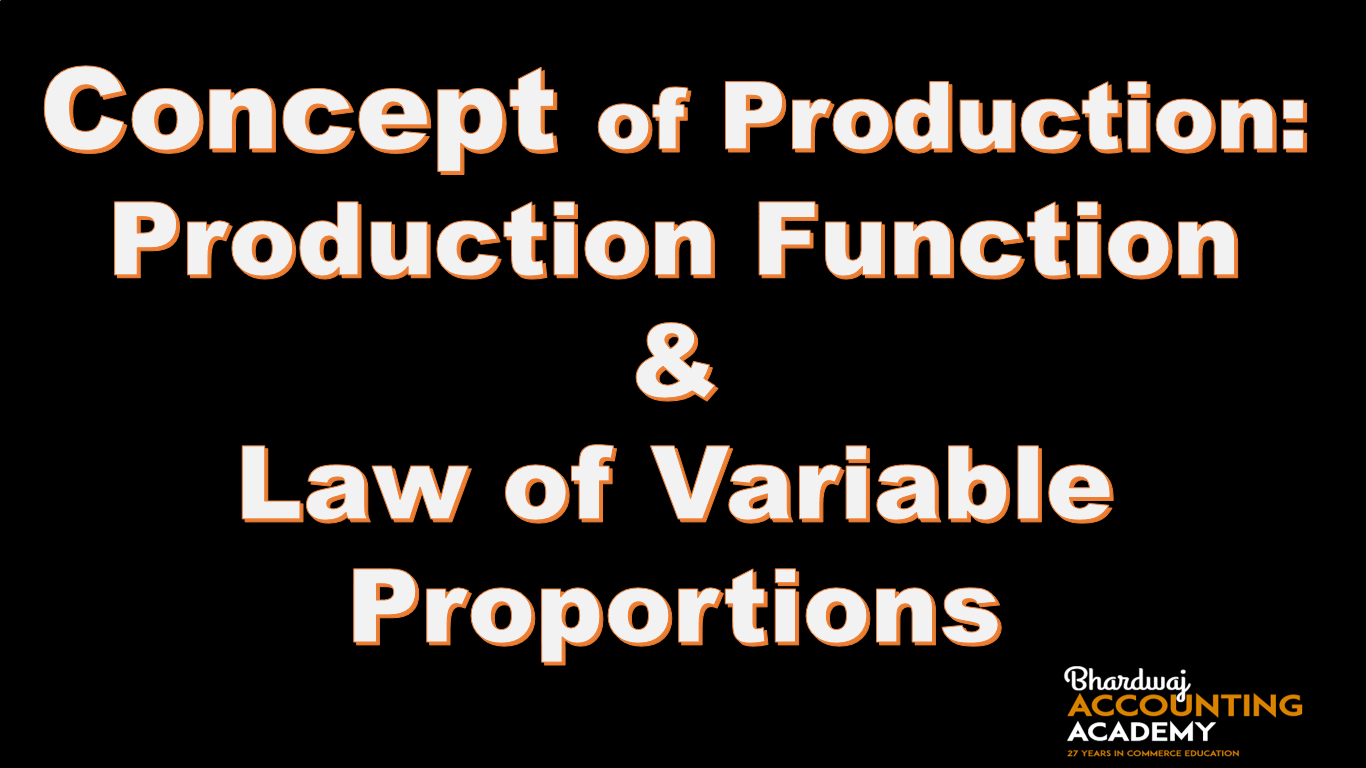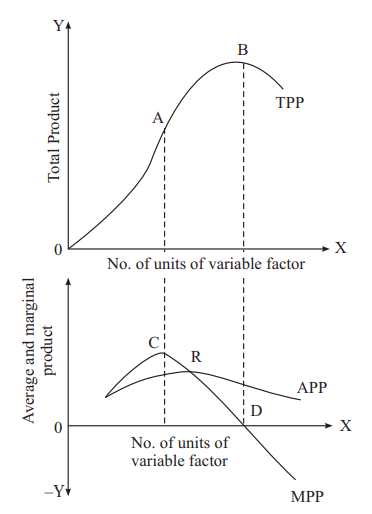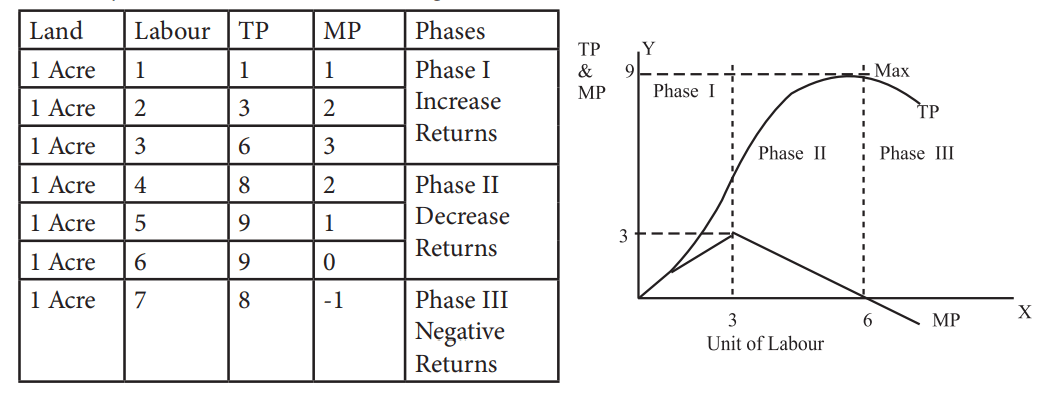Table of Contents
Concept of Production: Production Function and Law of Variable Proportions
Concept of Production:
production:

The act of making goods and services is called production. It is also defined as the process of transformation of physical inputs into physical output.
In other words- Production means the creation of utility.
According to A.H. smith “ Production is the process that creates utility in goods and services”
It also refers to the creation of goods (or performance of services) for the purpose of selling them in the market.
Factors of production:
Productive resources are known as factors of production.
Or
Resources used to produce goods and services are called factors of production. They are also called the inputs of production.
There are four main factors of production: land, labour, capital, and entrepreneur.

Concept of Production
Production function:
production function refers to the physical/ functional/ mathematical relationship between physical inputs and physical output under given technology at a given period of time.
O = f (L, Lr, C, E)
O = Output;
L = Land;
Lr = Labour;
C = Capital;
E = Entrepreneur;
F=Functional relationship
Concept of Production
Short Run:
Short run refers to a time period in which there are both Variable factors as well as Fixed Factors of production. In such a case, the output can be increased by the changing variable factors only. Production can be raised by increasing the variable factors but up to the maximum capacity of the Fixed Factors. Thus, supply cannot be increased in short run.
Long Run:
Long run refers to a time period in which all the factors of production are variable. In such a case, the output can be increased by changing all the factors. Production can be raised by changing factory size, switching to later technology etc. Thus, supply can be increased in the long run. The underlying theory to the long-run production function is the returns to scale.
Types of Production Function:
A . Short Run production function
A production function that shows the changes in output when only one factor is changed while the other factor remains constant is termed as a short-run production function. The underlying theory of the short-run production function is the “Law of variable proportion or Returns to a factor”.
B . Long Run production function
A long-run production function refers to a situation when output is increased by increasing all the inputs simultaneously and in the same proportion. The underlying theory of the Long-run production function is the “Law of Returns to scale/Fixed Proportions”.
Difference between Short run and Long run:
| Basis of Difference | Short Run | Long Run |
| Meaning | Short run refers to a time period in which there are both Variable factors as well as Fixed Factors of production. | Long run refers to a time period in which all the factors of production are variable. In such a case, the output can be increased by changing all the factors. |
| Classification | In short run, factors can be classified as Variable Factors and Fixed Factors | In long run, all the factors are Variable |
| Output | Output can be raised by varying variable factors and by maximum utilisation of fixed factors. | Output can be raised by changing all factors. |
| Production | In short run, Production can be raised but up to a limit. | In the long run, production can be raised without limit. |
| Supply | Supply cannot be changed in the short run. | Supply can be changed in long run. |
| Example | A period of 1 year is short run for a car producer. | While a period of 1 year is long run for a wheat producer. |
Concept of Production
Variable Factors:
Variable/Prime/Primary inputs are those which can be changed in the short run to
change the level of output viz. daily labour, raw materials, fuel, transportation etc.
Fixed Factors:
Fixed/Secondary/supplementary/Overhead inputs are those whose use can’t be changed in
the short run in order to change the level of output, viz. land, fixed capital, organization.
Difference between variable factors and fixed factors:
| Basis of Difference | Variable Factors | Fixed Factors |
| Meaning | Variable factors refers to those factors/ inputs which can be changed in the short run. | Fixed Factors refers to those factors which cannot be changed in the short run. |
| Effect | Variable factors are directly affected by changes in production. | Fixed factors are not affected by changes in production in the short run. |
| Relation with Output | The requirement of variable factors depends on the output requirement in the short run. | The quantity of fixed factors remains the same irrespective of output requirement in the short run. |
| Zero Output | In the case of zero output, variable factors can be zero. | Fixed Factors cannot be zero irrespective of the level of output. |
| Example | Labour, fuel, raw material, transportation etc. | Land, building, plant, machinery etc. |
Concept of Production
Concept of Product:
Product:
Product refers to the volume of goods produced by a firm or an industry during a particular period of time. There are three measures of Product or Production:
Three measures of production:
Before studying the law of variable proportions we have to understand the three measures of production and their relationships because without understanding these measures of production, the concepts of laws of production can not be clearly understood.
There are mainly the following three measures of production:
(a) Total product or total physical product denoted by TPP.
(b) Average Product (AP) or Average physical produt denoted by APP.
(c) Marginal Product (MP) or marginal physical product denoted by MPP.
(a) Total product(TP) or Total physical product denoted by TPP:
Total Product(TP) is the total amount of a commodity that is produced with a given level of factor inputs and technology during a given period of time.
Or
Total product refers to the total quantity of goods produced by a firm with a given level of factor inputs and technology during a given period of time.
For example, 2 units of labour combined with 1 unit of capital can produce 10 Chairs per day.
Here 10 Chairs is the total physical product which is produced with the given level of inputs (labour(Variable) and capital(Fixed).
TP = ƩMP
TP = AP X No of Variable Factor
(b) Average Product (AP) or Average physical product denoted by APP:
Average Product (AP) is defined as the output per unit of variable input.
In the other words – APP is the output produced per unit of input employed.
It is obtained by dividing Total Product by the quantity of variable factor.
AP = TP / No. of Variable Factor
(c) Marginal Product (MP) or Marginal physical product denoted by MPP:
Marginal Product (Mp) is defined as change in total product when an additional unit of Variable factor get employed, keeping other factors fixed.
In the other words – MPP of an input is the additional output that can be produced by employing one more unit of that input while keeping other inputs constant.
For example, if 10 Workers can make 50 Chairs per day and 11 Workers can make 62 Chairs per day, the marginal product of 11th workers will be 62 – 50 = 12 Chairs per day
MPn = TPn – TPn-1
MP = ΔTP/Δ Variable Factor
RELATIONSHIP BETWEEN TPP AND MPP:
The relationship between TPP and MPP can be explained as given below:
i)As long as MPP increases, TPP increases at an increasing rate.
ii)When MPP falls but remains positive, TPP increases but at a diminishing rate.
iii)When MPP becomes zero, TPP is maximum.
iv)If MPP becomes negative, TPP starts decreasing.
RELATIONSHIP BETWEEN APP AND MPP:
(i)As long as MPP is greater than APP, APP increases.
(ii)When MPP is equal to APP, APP is maximum and constant.
(iii)When MPP is less than APP, APP decreases.
(iv)MPP can be zero and negative but APP is never zero or negative.
Relationship among TPP, APP and MPP (through diagram):
SUPPLY AND ITS DETERMINANTS/FACTORS AFFECTING SUPPLY
Concept of Production
LAW OF VARIABLE PROPORTIONS Or ‘Law of Returns’ Or ‘Law of Returns to Factor’ Or ‘Returns to Variable Factor’
Law of Variable Proportions (LVP) states that as we increase quantity of only one input keeping other inputs fixed, total product (TP) initially increases at an increasing rate, then at a decreasing rate and finally at a negative rate.
According to the Law of Variable Proportions, the changes in TP and MP can be classified into the following three Phases:
Phase I: TP rises at an increasing rate. MP increases.
Phase II: TP rises at decreasing rate. MP decreases and is positive.
Phase III: TP falls. MP becomes negative.
The law states that “Ceteris paribus, when a firm employs additional units of a variable input (say labour) in the short run, while other inputs remain fixed, initially the TP rises at increasing rate (i.e. MP rises); after a certain period of time the TP rises but at diminishing rate (i.e. MP falls); and finally the TP declines (i.e. MP is negative).” and fnally the TP declines (i.e. MP is negative)”
Assumption Of The Law OF VARIABLE PROPORTIONS:
The law operates under the following assumptions:
(i) It operates in the short run.
(ii) There is no change in the technology of production.
(iii) The production process allows the different factor ratios to produce different levels of output.
(iv)All the units of variable factors are equally efficient.
(v)Full substitutability of factors of production is not possible.
(vi) In a production process when only one factor is varied and all other factors remain constant.
(vii) This law applies to the field of production only.
Concept of Production
There are three phases of returns to a variable factor:
Phase I
Increasing Returns to a factor In this phase TP increases at an increasing rate and marginal product of the variable factor, labour increases. In the end of this phase MP is maximum. So, this is the phase of increasing returns to a factor.
Phase II
Diminishing Returns to a factor In this phase TP increases but at a diminishing rate MP declines but remains positive. At the end of this phase, MPP is zero. At this point TP is maximums. So, this is the phase of diminishing returns to a factor.
Phase III
Negative Returns to a factor In this phase, MP declines and it becomes negative. Here the TP also starts falling. It operates from the level of output where the MPP of labour is zero but subsequently becomes negative.
Concept of Production
INCREASING RETURN TO A FACTOR
1. Better utilization of fixed factors.
2. Labour division benefits.
3. Efficient use/utilization of variable factors.
4. Better coordination
DIMINISHING RETURNS TO A FACTOR
1. Inadequate factor proportion.
2. Optimum combination.
3. Imperfect substitution of factors
4. Poor Coordination
5. Over utilization ( Fixed Factor)
NEGATIVE RETURN TO A FACTOR
1. Fixity of Fixed Factors/Limitation of fixed factor.
2. Defective factor ratio
3. Overcrowding of Variable Factors.
4. Decrease in the efficiency of the variable factor.
Concept of Production


